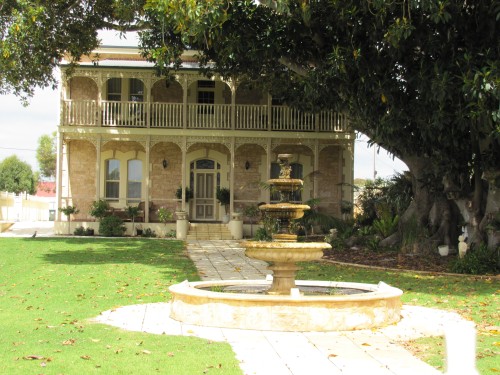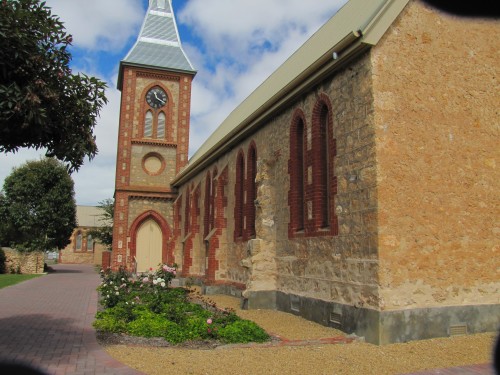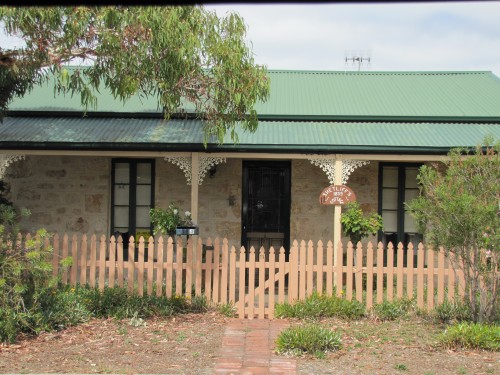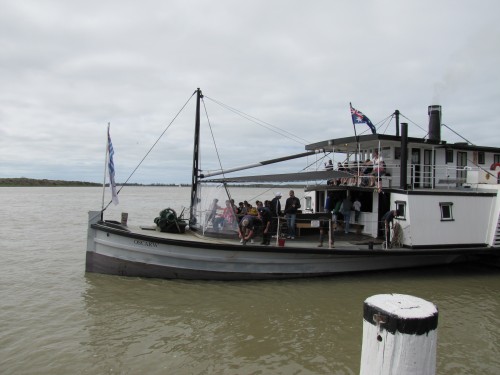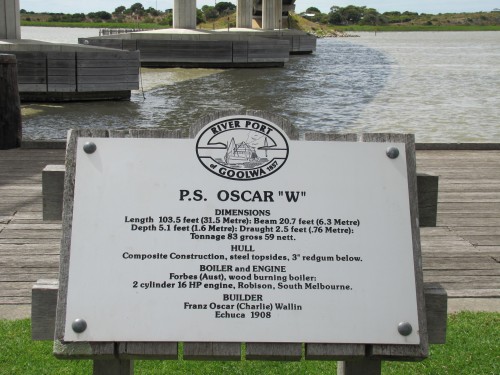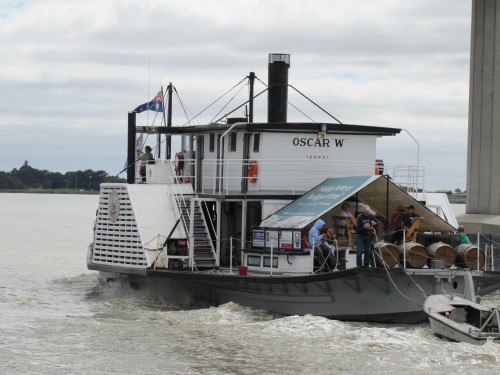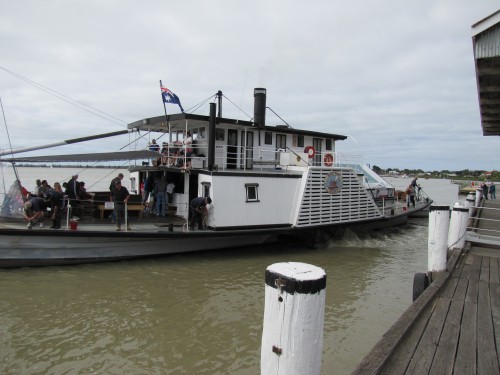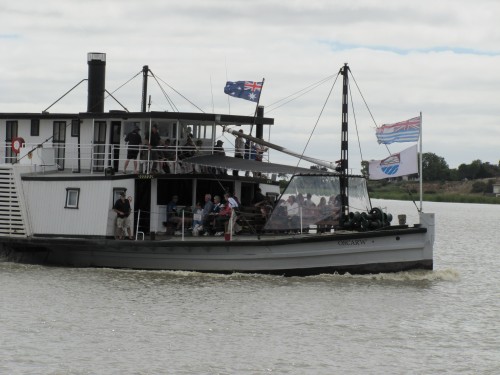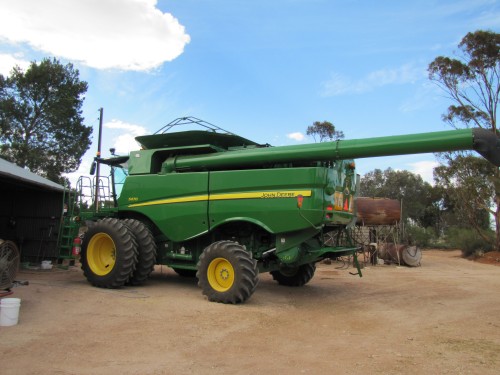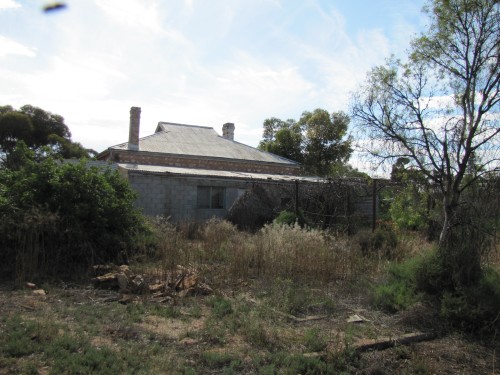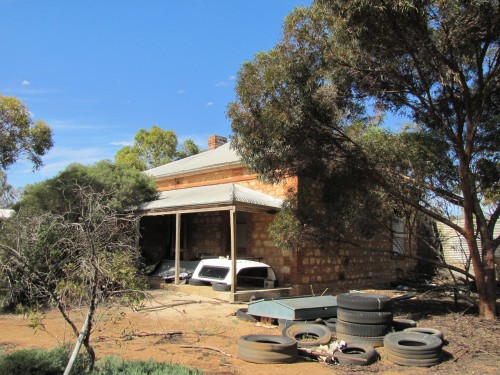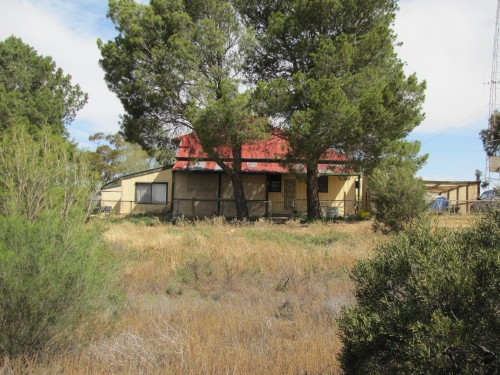Old buildings in Goolwa
Over the last few days I have written about a tour of the historic town of Goolwa south of Adelaide. We went with my friend Rod and his wife in their wonderful old 1928 Model A Ford.
During our time in Goolwa we stopped several times to go for a walk, looking around at some of the old historic towns still being used today.
Goolwa was a very important town in the development of South Australia. It was even considered at one point for building of the capital of the state.
The Port of Goolwa served the enormous river boat trade of the Murray-Darling River system, Australia’s major river. Its mouth is a few kilometres from the town. Farming produce and goods for the towns along the rivers were transported in the early days of colonial Australia. The advancing railway network soon brought this trade to an end. Now the river boats are returning as tourist interest in the river system increases. Now many house boats ply these waters.
Oscar W at River Port Goolwa
Some time ago now I took a series of photos on a visit to Goolwa near the mouth of the River Murray in South Australia. we were visiting friends who live in the nearby seaside town of Victor Harbor, about an hour south of Adelaide and just over an hour’s drive from our home in Murray Bridge.
Rod took us on a tour of the local sights in his 1928 Model A Ford with the simple name of “Don”. Several times I have been driving with him in his old car and I always enjoy the experience. On this occasion we drove to Goolwa, a town on the banks of Australia’s largest river. The port of Goolwa was a bustling river port in the 1800s, transporting goods to and from farming areas upstream in the Murray-Darling river system. The goods were then taken by train – Australia’s first railway – to the port at Victor Harbor. In its heyday this was amongst the busiest ports in the country. The quick spread of the railway system soon saw the demise of this important port.
These days, Goolwa is both a busy retirement town and tourist destination. Every two years the town hosts the South Australian Wooden Boats Festival, attracting many people from all over to see these wonderful old craft. Visitors can also take cruises on the River Murray on a variety of vessels, including the Oscar W shown in today’s photos.
I have been promising my wife a trip on one of these boats for some year now. I had better keep my promise soon – an opportunity for more photos.
Modern farming machinery at Taplan
The last time I visited Taplan was during the Railway Centenary Celebrations in October 2013. Taplan is a small farming community about 30km south-east of Loxton in South Australia. I have written extensively of this town and district in recent days here on this site. Taplan is the small town where I grew up on my father’s farm. When my father retired into Loxton, my brother took over the family farm. When he retired my nephew took over and his sons look like keeping the trend going in the years to come.
On that last visit my brother took me to my nephew’s farm to show me the harvester (see photo above) he uses when reaping the cereal crops, mainly wheat and canola. A machine like this is expensive, somewhere in the region of three-quarters of a million dollars. He has since traded this machine in on a new one.
Sometimes my brother and I reminisce about the days when our father started out farming. He started in the late 1920s with a six foot (1.8 metre) comb on his wheat harvester. It was pulled by a team of horses. The new machine does cuts 54 feet wide (16.45 metres). And he doesn’t actually have to “drive” it because it is GPS guided with constant computer analysis of the yield of each section of the paddock. Our father would not believe what my nephew is doing to improve the productivity of the land he once farmed, or the machinery he now uses.
Even I can hardly believe it.
Where I grew up at Taplan
Taplan is a small farming community about 30km south east of Loxton in the Murray Mallee region of South Australia. The town was established in the early 1900s and was the result of clearing much of the mallee (eucalyptus) scrub over many years of hard work. These days the area is mainly a cereal growing area – wheat, barley, canola and some oats. Some sheep and cattle are also kept by local farmers.
I grew up in this town in the 1950s and 60s. Over recent days on this site I have written about school life and other aspects of life in this small community. Today the town is a mere shadow of its former self. Many houses are now empty, including the one shown in today’s photos, the Institute Hall and the primary school are now private residences, the post office and store have closed and the only church (Lutheran) often has only half a dozen people attending. The railway ceased operating some years ago too.
My parents moved to this district when they married in the late 1920s. My father farmed the family land, initially about 600 acres but later over 1000 acres as he bought adjoining properties. My brother bought another farm a few miles to the north when he married. Later, when another brother married he bought the original farm from my father. Both of these properties have since been bought by my nephew who has expanded even further with several more properties bought in recent years. It seems quite likely that one or more of his three sons will soon be working these properties with their father.
The old homestead shown in today’s photos is where I grew up from 1947 until my parents and I moved to Loxton in 1965. During those years I enjoyed a wonderful childhood playing around the house and helping my mother in the garden. Our extensive garden included many fruit trees, such as:
- oranges
- lemons
- mandarins
- nectarines
- apricots
- peaches
- pears
- loquats
- figs
- grapes
- passion-fruit
In the vegetable garden we grew:
- carrots
- cauliflower
- cabbage
- lettuce
- pumpkins
- watermelons
- rockmelons
- beetroot
- tomatoes
- turnips
- and probably quite few I have forgotten.
We had a small herd of cows but I never had the job of milking them. My job was to take the milk, pour it into a separator and turn the handle until the cream was separated from the milk. Sometimes I helped my mother make homemade butter. Any leftover milk was given to the small herd of pigs which were also our source of meat. Very rarely did we eat our own ham or bacon. More often it was either poultry – such as chicken or duck – or mutton from sheep which my father would butcher. Any excess cream was sold, the large cans of cream being transported to Murray Bridge (where I now live) by train in refrigerated vans.
The chickens – we always called them “chooks” – were largely my responsibility. While I did provide them with some wheat or other grain to eat, most of the time the chooks foraged in the garden, around the sheds or even out in the nearby paddocks. We invented “free range eggs” before it was fashionable.
My job every evening was to “look for the eggs”. I didn’t just have to gather the eggs from the laying boxes in their shed, I actually had to actively search out where they were laying. This could be anywhere in the implement sheds, in farm machinery, behind boxes, under bushes – I had to use my keenly developed eyesight to watch where the hens were so I could find their eggs.
I was not always as alert as the hens were cunning. They would lay their eggs in a secret place until they had ten or fifteen, and then they would go “broody”. I quickly learned that the peck of a broody hen hurt, so often I would leave them be. A few weeks later a new batch of fluffy chickens would grace our farm yard. In this way we replenished those we had eaten. Of course we always had far too many eggs and no matter how many wonderful cakes and biscuits mum made, there was always an excess, and these I had to wipe clean with a damp cloth before packing them in specially designed crates. These crates were taken to the nearby railway station and transported off to markets in Adelaide.
The area immediately surrounding the house and sheds of our homestead consisted of a large patch of native mallee (eucalyptus) scrub. I am much younger than my three brothers who were never much interested in playing with me when I was growing up, except when I was a baby. During my school days I had to entertain myself during school holidays and on weekends. The nearby scrub kept me very entertained as I explored it, developing a love of the environment which persists to this day. I now own a little patch of mallee scrub where I now live in Murray Bridge. You can see photos of birds seen around my home on Trevor’s Birding.
The last photo I will share today is another view of the house on the farm where I grew up. It is now a ruin; my brother built a new house just a few metres north of this one a few years after he married. It is sad to see so many similar old homes like this one going to ruin, but that is just the way things are; there is no use bemoaning the fact that maintenance on old houses is expensive, and there is just not the concentration of population in rural Australia to keep houses like this occupied.
Taplan Primary School
During the Taplan Railway Centenary celebrations in October 2013, I took a wander through the small town where I grew up in the 1950s and 60s. One of the buildings which took some of my attention was the former Taplan Primary School, now a private residence, shown in the photo above. Taplan is a small town some 30km south-east of Loxton, in the Murray Mallee region of South Australia and only 8km from the Victorian border.
This school opened in the early 1900s but I am not sure when it closed, possibly in the 1970s. I can’t find any references to its year of operating online but I do have a history book on the town at home – but I am writing this in Sydney – two days’ drive away. (I will update this next week.) Update: The school shown in the photo above opened in 1927 and closed in 1967. Previously a school was conducted in the galvanised iron room at the back of the Institute Hall from 1917 until 1928.
When I attended the school in the 1950s this was a thriving school with – if my memory serves me correctly after all these years – an enrolment of between 30 and 40 children. I seem to remember that it catered for even more before I started, but numbers gradually dwindled to fewer than a dozen before closing permanently. For most of the time, the school operated it employed only one teacher for all seven grades in the one room. For a brief period during my schooling, there was a part-time second teacher, who just happened to be a second cousin.
The school population came from the few houses in the town and the families of the workers on the railway maintenance gangs. By far the bulk of the students, however, came from the surrounding farming community. As farms were amalgamated families moved elsewhere. Other families chose to send their children by bus to the schools in Loxton, especially the newly opened Lutheran School. This eventually caused small schools like Taplan to close.
I have many fond memories of my days in primary school. My teacher, Mr Peter Evans, was in fact, the only teacher I had during my entire primary schooling. I enjoyed his style of teaching so much that he inspired me to become a teacher. I served in a variety of South Australian schools for 35 years until my retirement in 2004. He inspired a lifelong love of learning, reading and the environment.
The school grounds were extensive, with a large gravel covered play area which hosted many great cricket and football matches. The playground equipment was basic: 2 swings, a large see-saw, a zig-zag and some monkey bars for climbing. The lack of equipment did nothing to quell our imagination, though. The playground extended into a 5 acre (2ha) patch of mallee scrub, a great place for adventures of all kinds, from hide-and-seek through to pirates and western sagas and the occasional mini world war. Like most children we let our imaginations soar in all directions, creating games on the run.
Next to the main playground the parents’ association had created a vegetable garden. We had regular lessons in gardening and each student had their own plot to grow whatever they liked. I loved growing carrots, beetroot, turnips and a range of other vegetables. When I picked the results of my labours I was so proud taking home the produce for the family to eat. These skills carried over to the home patch of vegetables where I regularly helped my mother. Strangely, this early interest in growing vegetables has not fully extended into my adult life, except the times when I help my wife in the garden. I still enjoy working in the garden – as my back allows – but it seems not to be a high priority these days.
One last memory of my time at this school: the 40-metre strip of roadside verge between the main street and the school property was the scene of an annual tree planting ceremony. On Arbor Day many of us would plant a new tree or shrub in this nature strip. For many years this plantation thrived and made a great addition to the local town environment. Since the school has closed this plantation has deteriorated through neglect. Many of the trees have also died out through lack of watering; the Taplan summers can be very hot and dry and some trees were inappropriate for the region’s climate.
Updated 30th December 2016.
